Case Study: Community-Based HIV Prevention and Management, QLD
VerifiedAdded on 2023/06/11
|28
|6463
|151
Case Study
AI Summary
This case study investigates the effectiveness of community-based nursing interventions for HIV prevention and management in Queensland, Australia. It begins by outlining the global HIV epidemiology, highlighting risk factors such as sexual behavior and knowledge gaps. The proposed action plan details a qualitative approach, targeting 100 people living with HIV/AIDS (PLHA) through purposive sampling. The intervention involves workshop seminars focused on increasing awareness, equipping participants with leadership skills, and initiating community projects. Data collection methods include in-depth interviews, field notes, case records, and literature reviews. The study anticipates lower HIV/AIDS cases, improved behavioral change, and better-addressed risk factors, with strategies to evaluate outcomes. A timeline and budget are proposed to guide the implementation of this community-based intervention.
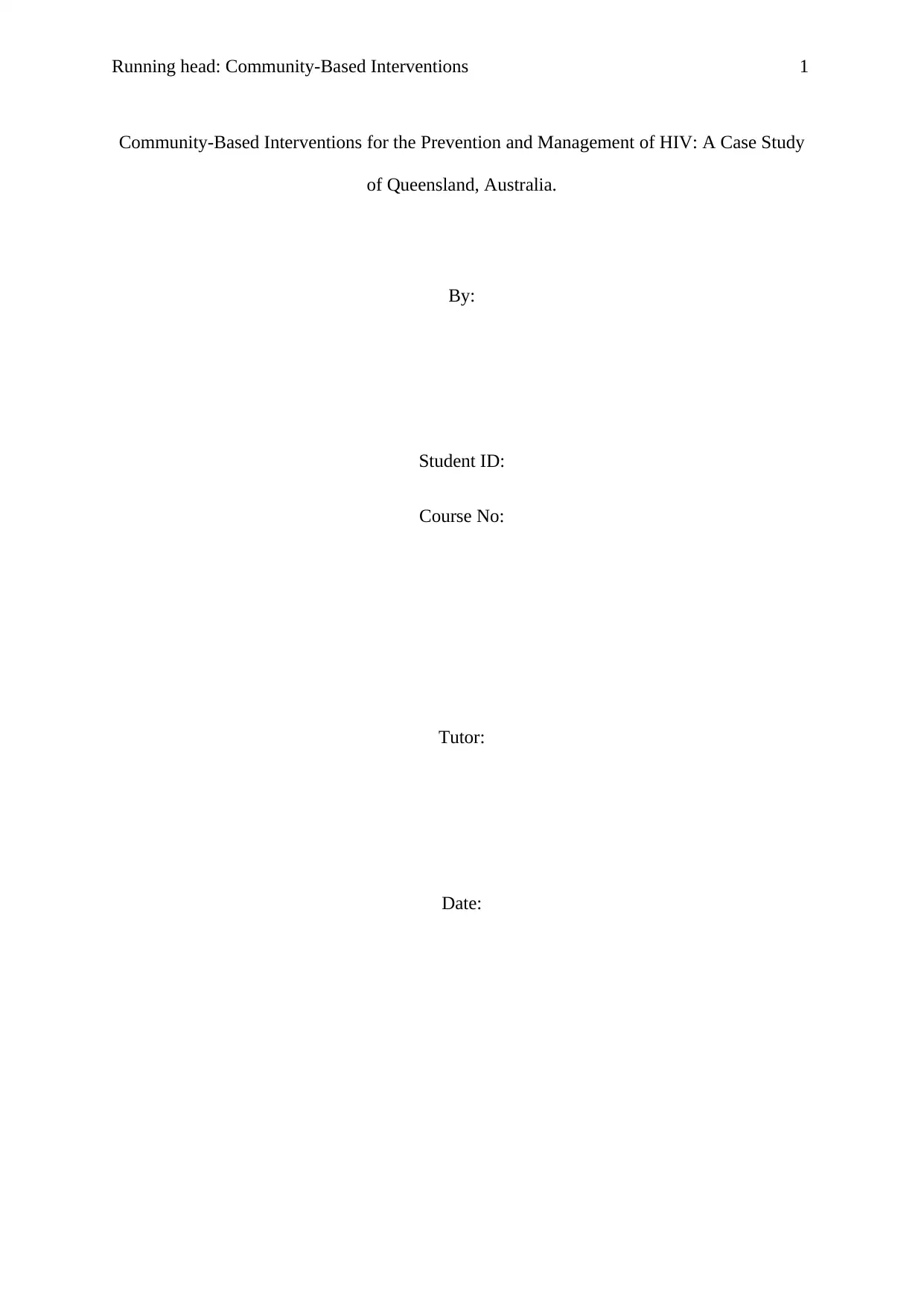
Running head: Community-Based Interventions 1
Community-Based Interventions for the Prevention and Management of HIV: A Case Study
of Queensland, Australia.
By:
Student ID:
Course No:
Tutor:
Date:
Community-Based Interventions for the Prevention and Management of HIV: A Case Study
of Queensland, Australia.
By:
Student ID:
Course No:
Tutor:
Date:
Paraphrase This Document
Need a fresh take? Get an instant paraphrase of this document with our AI Paraphraser
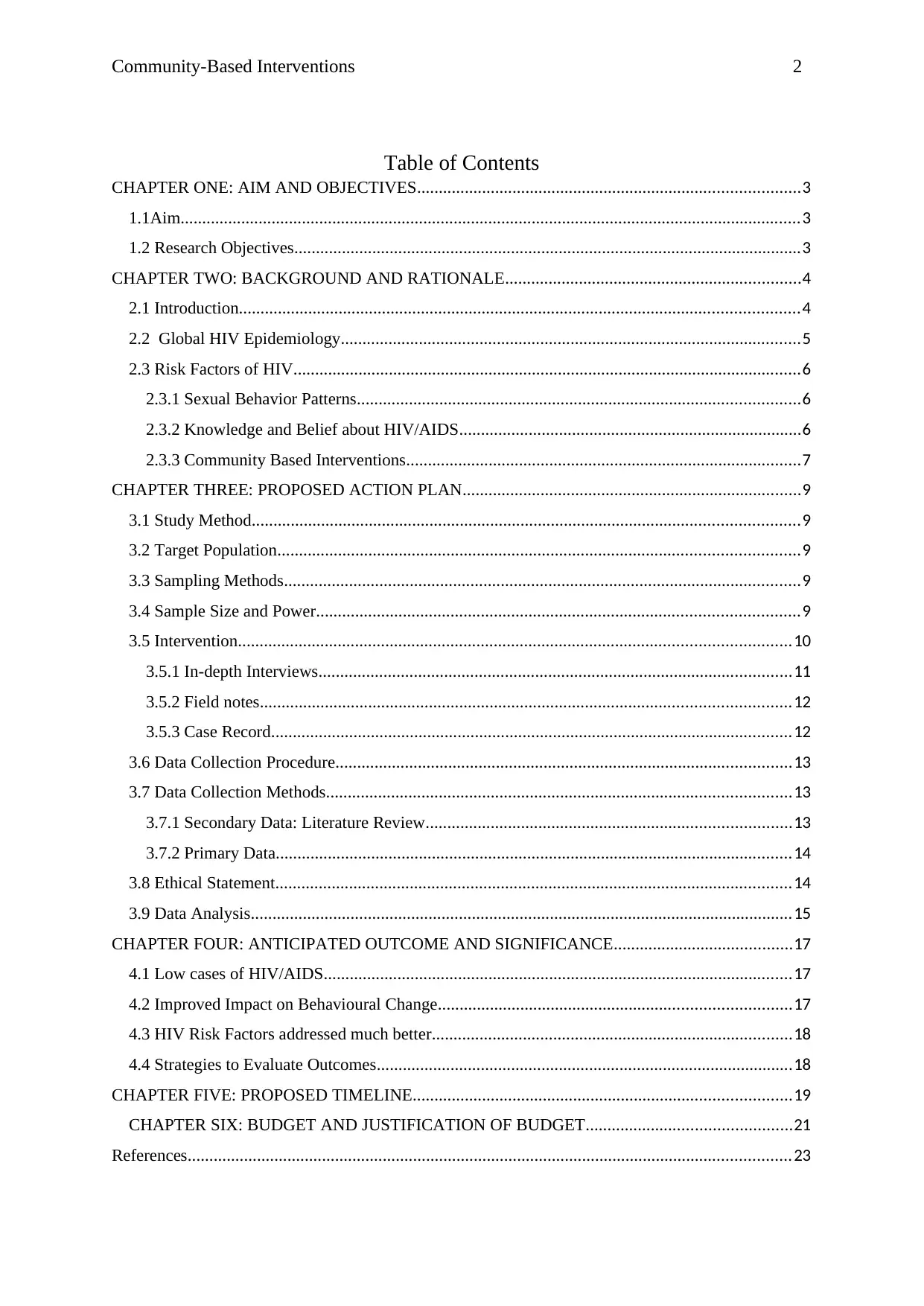
Community-Based Interventions 2
Table of Contents
CHAPTER ONE: AIM AND OBJECTIVES........................................................................................3
1.1Aim...............................................................................................................................................3
1.2 Research Objectives.....................................................................................................................3
CHAPTER TWO: BACKGROUND AND RATIONALE....................................................................4
2.1 Introduction.................................................................................................................................4
2.2 Global HIV Epidemiology..........................................................................................................5
2.3 Risk Factors of HIV.....................................................................................................................6
2.3.1 Sexual Behavior Patterns......................................................................................................6
2.3.2 Knowledge and Belief about HIV/AIDS...............................................................................6
2.3.3 Community Based Interventions...........................................................................................7
CHAPTER THREE: PROPOSED ACTION PLAN..............................................................................9
3.1 Study Method..............................................................................................................................9
3.2 Target Population........................................................................................................................9
3.3 Sampling Methods.......................................................................................................................9
3.4 Sample Size and Power...............................................................................................................9
3.5 Intervention...............................................................................................................................10
3.5.1 In-depth Interviews.............................................................................................................11
3.5.2 Field notes..........................................................................................................................12
3.5.3 Case Record........................................................................................................................12
3.6 Data Collection Procedure.........................................................................................................13
3.7 Data Collection Methods...........................................................................................................13
3.7.1 Secondary Data: Literature Review....................................................................................13
3.7.2 Primary Data.......................................................................................................................14
3.8 Ethical Statement.......................................................................................................................14
3.9 Data Analysis.............................................................................................................................15
CHAPTER FOUR: ANTICIPATED OUTCOME AND SIGNIFICANCE.........................................17
4.1 Low cases of HIV/AIDS............................................................................................................17
4.2 Improved Impact on Behavioural Change.................................................................................17
4.3 HIV Risk Factors addressed much better...................................................................................18
4.4 Strategies to Evaluate Outcomes................................................................................................18
CHAPTER FIVE: PROPOSED TIMELINE.......................................................................................19
CHAPTER SIX: BUDGET AND JUSTIFICATION OF BUDGET...............................................21
References...........................................................................................................................................23
Table of Contents
CHAPTER ONE: AIM AND OBJECTIVES........................................................................................3
1.1Aim...............................................................................................................................................3
1.2 Research Objectives.....................................................................................................................3
CHAPTER TWO: BACKGROUND AND RATIONALE....................................................................4
2.1 Introduction.................................................................................................................................4
2.2 Global HIV Epidemiology..........................................................................................................5
2.3 Risk Factors of HIV.....................................................................................................................6
2.3.1 Sexual Behavior Patterns......................................................................................................6
2.3.2 Knowledge and Belief about HIV/AIDS...............................................................................6
2.3.3 Community Based Interventions...........................................................................................7
CHAPTER THREE: PROPOSED ACTION PLAN..............................................................................9
3.1 Study Method..............................................................................................................................9
3.2 Target Population........................................................................................................................9
3.3 Sampling Methods.......................................................................................................................9
3.4 Sample Size and Power...............................................................................................................9
3.5 Intervention...............................................................................................................................10
3.5.1 In-depth Interviews.............................................................................................................11
3.5.2 Field notes..........................................................................................................................12
3.5.3 Case Record........................................................................................................................12
3.6 Data Collection Procedure.........................................................................................................13
3.7 Data Collection Methods...........................................................................................................13
3.7.1 Secondary Data: Literature Review....................................................................................13
3.7.2 Primary Data.......................................................................................................................14
3.8 Ethical Statement.......................................................................................................................14
3.9 Data Analysis.............................................................................................................................15
CHAPTER FOUR: ANTICIPATED OUTCOME AND SIGNIFICANCE.........................................17
4.1 Low cases of HIV/AIDS............................................................................................................17
4.2 Improved Impact on Behavioural Change.................................................................................17
4.3 HIV Risk Factors addressed much better...................................................................................18
4.4 Strategies to Evaluate Outcomes................................................................................................18
CHAPTER FIVE: PROPOSED TIMELINE.......................................................................................19
CHAPTER SIX: BUDGET AND JUSTIFICATION OF BUDGET...............................................21
References...........................................................................................................................................23

Community-Based Interventions 3
⊘ This is a preview!⊘
Do you want full access?
Subscribe today to unlock all pages.

Trusted by 1+ million students worldwide
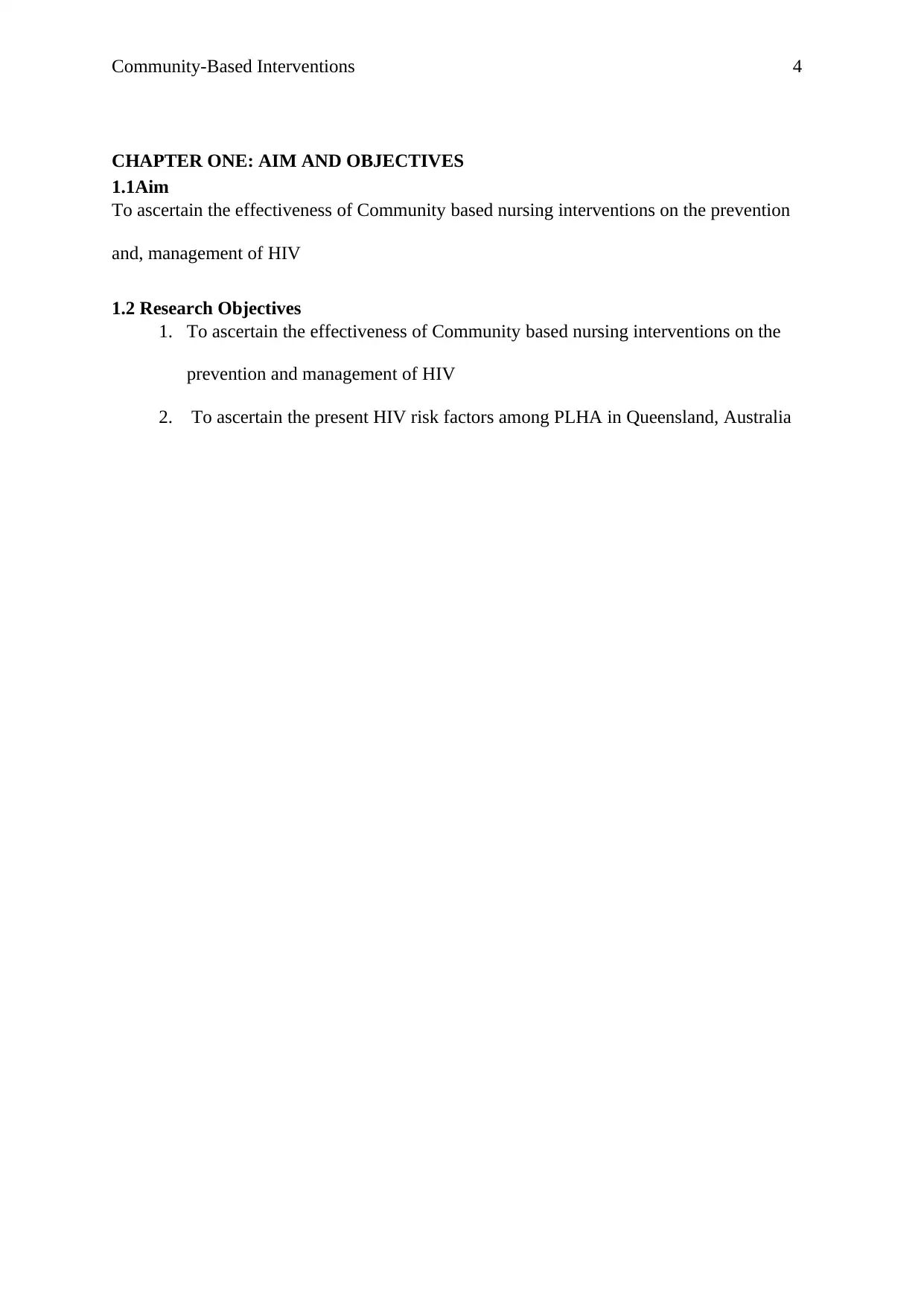
Community-Based Interventions 4
CHAPTER ONE: AIM AND OBJECTIVES
1.1Aim
To ascertain the effectiveness of Community based nursing interventions on the prevention
and, management of HIV
1.2 Research Objectives
1. To ascertain the effectiveness of Community based nursing interventions on the
prevention and management of HIV
2. To ascertain the present HIV risk factors among PLHA in Queensland, Australia
CHAPTER ONE: AIM AND OBJECTIVES
1.1Aim
To ascertain the effectiveness of Community based nursing interventions on the prevention
and, management of HIV
1.2 Research Objectives
1. To ascertain the effectiveness of Community based nursing interventions on the
prevention and management of HIV
2. To ascertain the present HIV risk factors among PLHA in Queensland, Australia
Paraphrase This Document
Need a fresh take? Get an instant paraphrase of this document with our AI Paraphraser
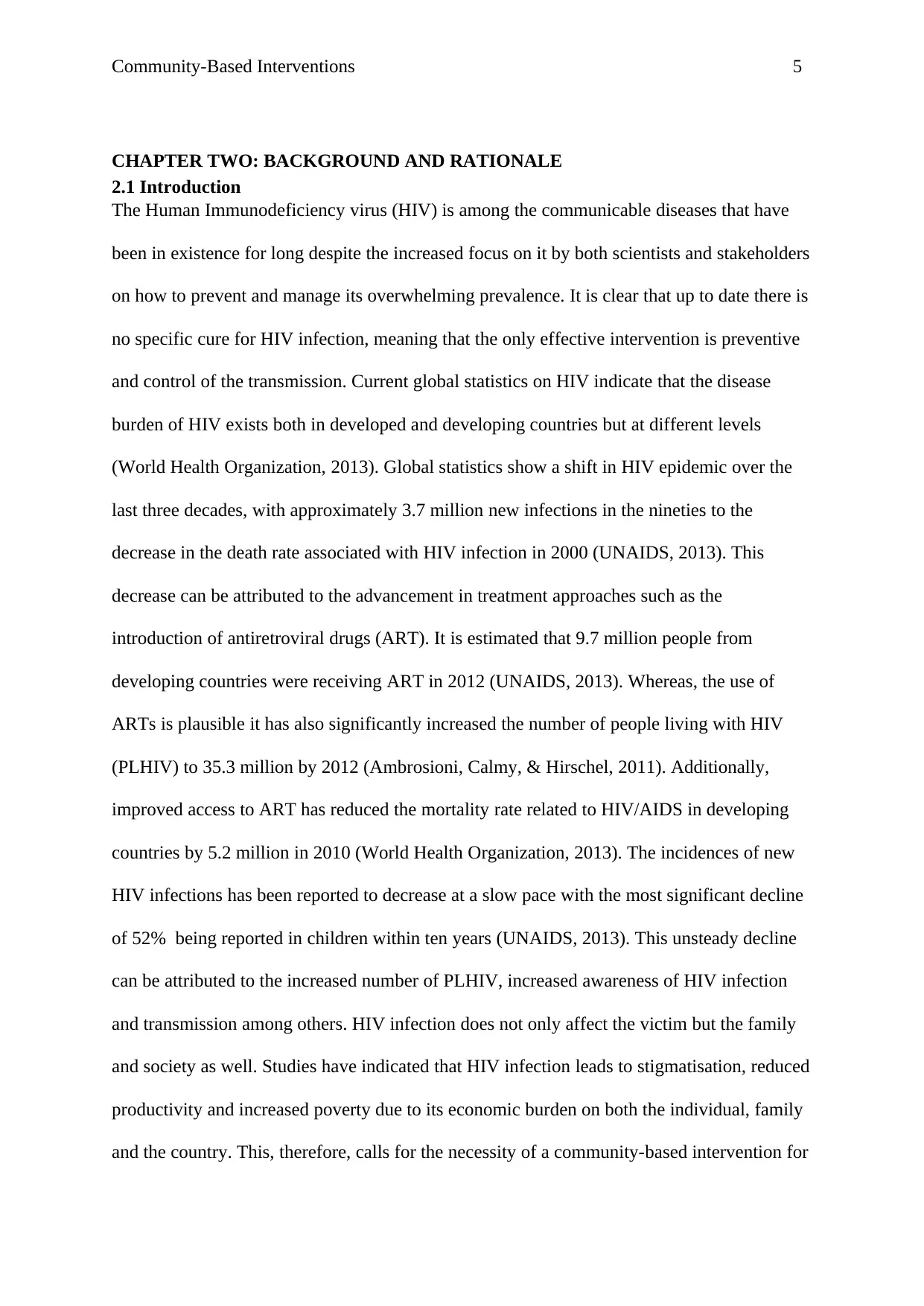
Community-Based Interventions 5
CHAPTER TWO: BACKGROUND AND RATIONALE
2.1 Introduction
The Human Immunodeficiency virus (HIV) is among the communicable diseases that have
been in existence for long despite the increased focus on it by both scientists and stakeholders
on how to prevent and manage its overwhelming prevalence. It is clear that up to date there is
no specific cure for HIV infection, meaning that the only effective intervention is preventive
and control of the transmission. Current global statistics on HIV indicate that the disease
burden of HIV exists both in developed and developing countries but at different levels
(World Health Organization, 2013). Global statistics show a shift in HIV epidemic over the
last three decades, with approximately 3.7 million new infections in the nineties to the
decrease in the death rate associated with HIV infection in 2000 (UNAIDS, 2013). This
decrease can be attributed to the advancement in treatment approaches such as the
introduction of antiretroviral drugs (ART). It is estimated that 9.7 million people from
developing countries were receiving ART in 2012 (UNAIDS, 2013). Whereas, the use of
ARTs is plausible it has also significantly increased the number of people living with HIV
(PLHIV) to 35.3 million by 2012 (Ambrosioni, Calmy, & Hirschel, 2011). Additionally,
improved access to ART has reduced the mortality rate related to HIV/AIDS in developing
countries by 5.2 million in 2010 (World Health Organization, 2013). The incidences of new
HIV infections has been reported to decrease at a slow pace with the most significant decline
of 52% being reported in children within ten years (UNAIDS, 2013). This unsteady decline
can be attributed to the increased number of PLHIV, increased awareness of HIV infection
and transmission among others. HIV infection does not only affect the victim but the family
and society as well. Studies have indicated that HIV infection leads to stigmatisation, reduced
productivity and increased poverty due to its economic burden on both the individual, family
and the country. This, therefore, calls for the necessity of a community-based intervention for
CHAPTER TWO: BACKGROUND AND RATIONALE
2.1 Introduction
The Human Immunodeficiency virus (HIV) is among the communicable diseases that have
been in existence for long despite the increased focus on it by both scientists and stakeholders
on how to prevent and manage its overwhelming prevalence. It is clear that up to date there is
no specific cure for HIV infection, meaning that the only effective intervention is preventive
and control of the transmission. Current global statistics on HIV indicate that the disease
burden of HIV exists both in developed and developing countries but at different levels
(World Health Organization, 2013). Global statistics show a shift in HIV epidemic over the
last three decades, with approximately 3.7 million new infections in the nineties to the
decrease in the death rate associated with HIV infection in 2000 (UNAIDS, 2013). This
decrease can be attributed to the advancement in treatment approaches such as the
introduction of antiretroviral drugs (ART). It is estimated that 9.7 million people from
developing countries were receiving ART in 2012 (UNAIDS, 2013). Whereas, the use of
ARTs is plausible it has also significantly increased the number of people living with HIV
(PLHIV) to 35.3 million by 2012 (Ambrosioni, Calmy, & Hirschel, 2011). Additionally,
improved access to ART has reduced the mortality rate related to HIV/AIDS in developing
countries by 5.2 million in 2010 (World Health Organization, 2013). The incidences of new
HIV infections has been reported to decrease at a slow pace with the most significant decline
of 52% being reported in children within ten years (UNAIDS, 2013). This unsteady decline
can be attributed to the increased number of PLHIV, increased awareness of HIV infection
and transmission among others. HIV infection does not only affect the victim but the family
and society as well. Studies have indicated that HIV infection leads to stigmatisation, reduced
productivity and increased poverty due to its economic burden on both the individual, family
and the country. This, therefore, calls for the necessity of a community-based intervention for
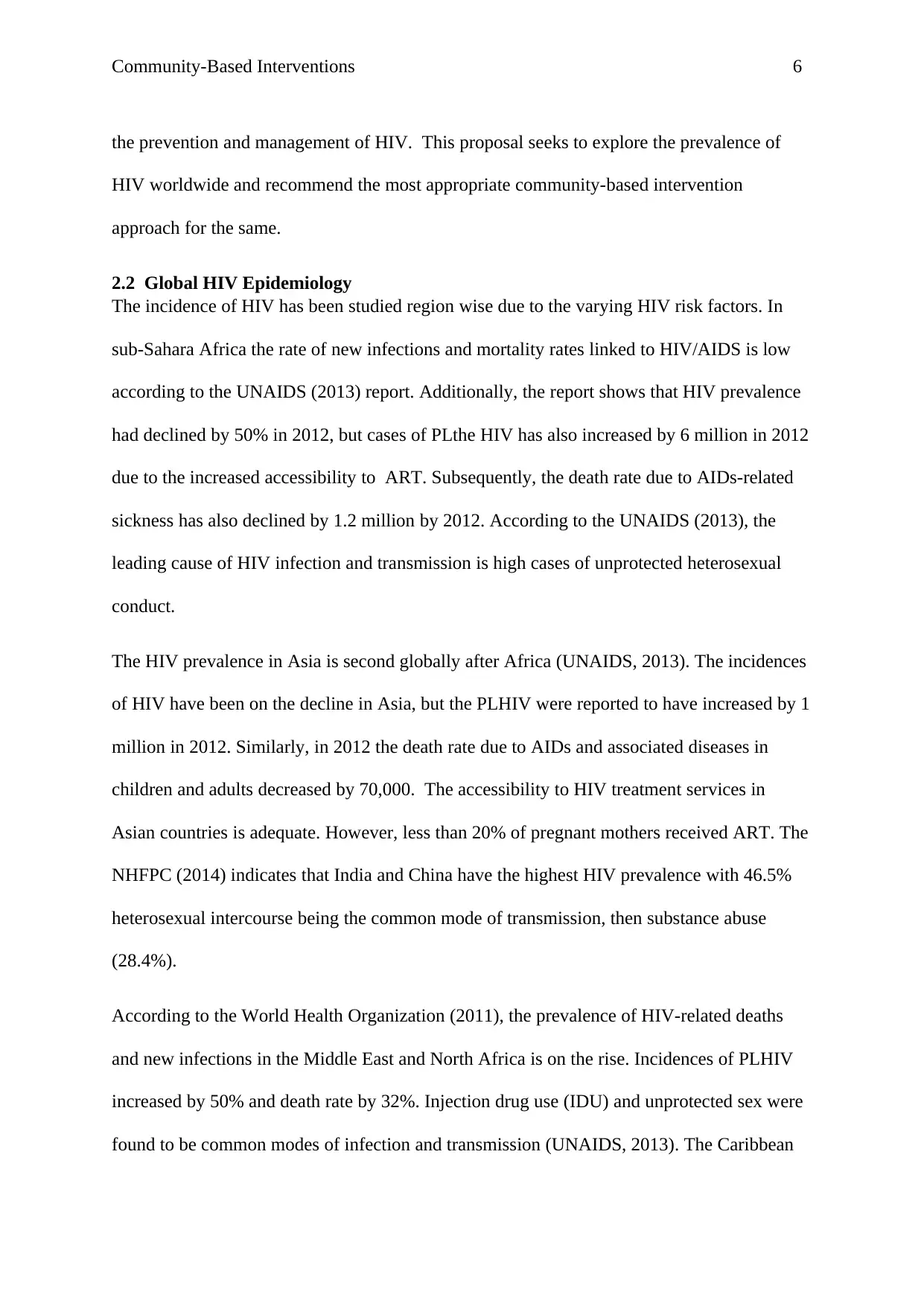
Community-Based Interventions 6
the prevention and management of HIV. This proposal seeks to explore the prevalence of
HIV worldwide and recommend the most appropriate community-based intervention
approach for the same.
2.2 Global HIV Epidemiology
The incidence of HIV has been studied region wise due to the varying HIV risk factors. In
sub-Sahara Africa the rate of new infections and mortality rates linked to HIV/AIDS is low
according to the UNAIDS (2013) report. Additionally, the report shows that HIV prevalence
had declined by 50% in 2012, but cases of PLthe HIV has also increased by 6 million in 2012
due to the increased accessibility to ART. Subsequently, the death rate due to AIDs-related
sickness has also declined by 1.2 million by 2012. According to the UNAIDS (2013), the
leading cause of HIV infection and transmission is high cases of unprotected heterosexual
conduct.
The HIV prevalence in Asia is second globally after Africa (UNAIDS, 2013). The incidences
of HIV have been on the decline in Asia, but the PLHIV were reported to have increased by 1
million in 2012. Similarly, in 2012 the death rate due to AIDs and associated diseases in
children and adults decreased by 70,000. The accessibility to HIV treatment services in
Asian countries is adequate. However, less than 20% of pregnant mothers received ART. The
NHFPC (2014) indicates that India and China have the highest HIV prevalence with 46.5%
heterosexual intercourse being the common mode of transmission, then substance abuse
(28.4%).
According to the World Health Organization (2011), the prevalence of HIV-related deaths
and new infections in the Middle East and North Africa is on the rise. Incidences of PLHIV
increased by 50% and death rate by 32%. Injection drug use (IDU) and unprotected sex were
found to be common modes of infection and transmission (UNAIDS, 2013). The Caribbean
the prevention and management of HIV. This proposal seeks to explore the prevalence of
HIV worldwide and recommend the most appropriate community-based intervention
approach for the same.
2.2 Global HIV Epidemiology
The incidence of HIV has been studied region wise due to the varying HIV risk factors. In
sub-Sahara Africa the rate of new infections and mortality rates linked to HIV/AIDS is low
according to the UNAIDS (2013) report. Additionally, the report shows that HIV prevalence
had declined by 50% in 2012, but cases of PLthe HIV has also increased by 6 million in 2012
due to the increased accessibility to ART. Subsequently, the death rate due to AIDs-related
sickness has also declined by 1.2 million by 2012. According to the UNAIDS (2013), the
leading cause of HIV infection and transmission is high cases of unprotected heterosexual
conduct.
The HIV prevalence in Asia is second globally after Africa (UNAIDS, 2013). The incidences
of HIV have been on the decline in Asia, but the PLHIV were reported to have increased by 1
million in 2012. Similarly, in 2012 the death rate due to AIDs and associated diseases in
children and adults decreased by 70,000. The accessibility to HIV treatment services in
Asian countries is adequate. However, less than 20% of pregnant mothers received ART. The
NHFPC (2014) indicates that India and China have the highest HIV prevalence with 46.5%
heterosexual intercourse being the common mode of transmission, then substance abuse
(28.4%).
According to the World Health Organization (2011), the prevalence of HIV-related deaths
and new infections in the Middle East and North Africa is on the rise. Incidences of PLHIV
increased by 50% and death rate by 32%. Injection drug use (IDU) and unprotected sex were
found to be common modes of infection and transmission (UNAIDS, 2013). The Caribbean
⊘ This is a preview!⊘
Do you want full access?
Subscribe today to unlock all pages.

Trusted by 1+ million students worldwide
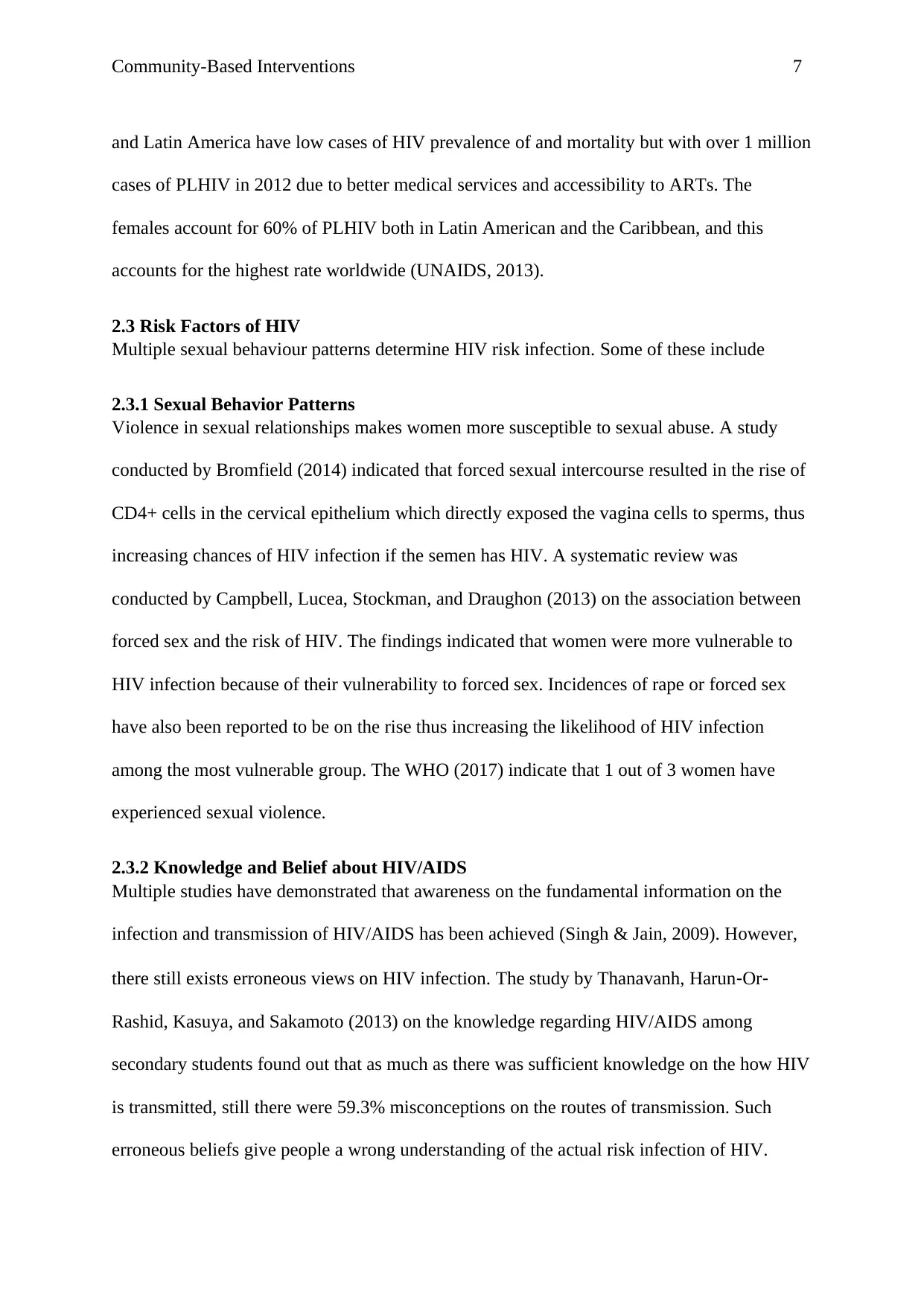
Community-Based Interventions 7
and Latin America have low cases of HIV prevalence of and mortality but with over 1 million
cases of PLHIV in 2012 due to better medical services and accessibility to ARTs. The
females account for 60% of PLHIV both in Latin American and the Caribbean, and this
accounts for the highest rate worldwide (UNAIDS, 2013).
2.3 Risk Factors of HIV
Multiple sexual behaviour patterns determine HIV risk infection. Some of these include
2.3.1 Sexual Behavior Patterns
Violence in sexual relationships makes women more susceptible to sexual abuse. A study
conducted by Bromfield (2014) indicated that forced sexual intercourse resulted in the rise of
CD4+ cells in the cervical epithelium which directly exposed the vagina cells to sperms, thus
increasing chances of HIV infection if the semen has HIV. A systematic review was
conducted by Campbell, Lucea, Stockman, and Draughon (2013) on the association between
forced sex and the risk of HIV. The findings indicated that women were more vulnerable to
HIV infection because of their vulnerability to forced sex. Incidences of rape or forced sex
have also been reported to be on the rise thus increasing the likelihood of HIV infection
among the most vulnerable group. The WHO (2017) indicate that 1 out of 3 women have
experienced sexual violence.
2.3.2 Knowledge and Belief about HIV/AIDS
Multiple studies have demonstrated that awareness on the fundamental information on the
infection and transmission of HIV/AIDS has been achieved (Singh & Jain, 2009). However,
there still exists erroneous views on HIV infection. The study by Thanavanh, Harun‐Or‐
Rashid, Kasuya, and Sakamoto (2013) on the knowledge regarding HIV/AIDS among
secondary students found out that as much as there was sufficient knowledge on the how HIV
is transmitted, still there were 59.3% misconceptions on the routes of transmission. Such
erroneous beliefs give people a wrong understanding of the actual risk infection of HIV.
and Latin America have low cases of HIV prevalence of and mortality but with over 1 million
cases of PLHIV in 2012 due to better medical services and accessibility to ARTs. The
females account for 60% of PLHIV both in Latin American and the Caribbean, and this
accounts for the highest rate worldwide (UNAIDS, 2013).
2.3 Risk Factors of HIV
Multiple sexual behaviour patterns determine HIV risk infection. Some of these include
2.3.1 Sexual Behavior Patterns
Violence in sexual relationships makes women more susceptible to sexual abuse. A study
conducted by Bromfield (2014) indicated that forced sexual intercourse resulted in the rise of
CD4+ cells in the cervical epithelium which directly exposed the vagina cells to sperms, thus
increasing chances of HIV infection if the semen has HIV. A systematic review was
conducted by Campbell, Lucea, Stockman, and Draughon (2013) on the association between
forced sex and the risk of HIV. The findings indicated that women were more vulnerable to
HIV infection because of their vulnerability to forced sex. Incidences of rape or forced sex
have also been reported to be on the rise thus increasing the likelihood of HIV infection
among the most vulnerable group. The WHO (2017) indicate that 1 out of 3 women have
experienced sexual violence.
2.3.2 Knowledge and Belief about HIV/AIDS
Multiple studies have demonstrated that awareness on the fundamental information on the
infection and transmission of HIV/AIDS has been achieved (Singh & Jain, 2009). However,
there still exists erroneous views on HIV infection. The study by Thanavanh, Harun‐Or‐
Rashid, Kasuya, and Sakamoto (2013) on the knowledge regarding HIV/AIDS among
secondary students found out that as much as there was sufficient knowledge on the how HIV
is transmitted, still there were 59.3% misconceptions on the routes of transmission. Such
erroneous beliefs give people a wrong understanding of the actual risk infection of HIV.
Paraphrase This Document
Need a fresh take? Get an instant paraphrase of this document with our AI Paraphraser
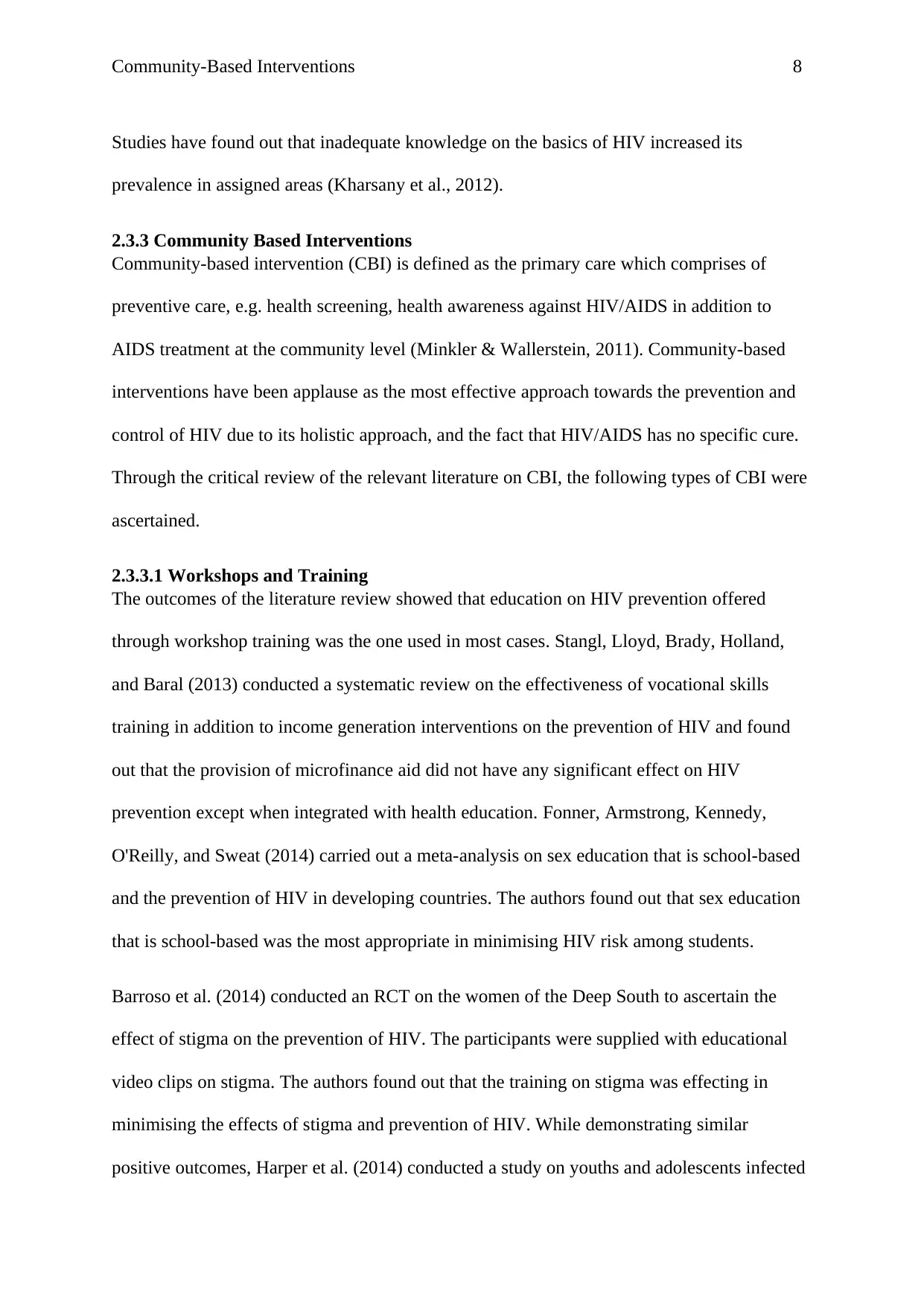
Community-Based Interventions 8
Studies have found out that inadequate knowledge on the basics of HIV increased its
prevalence in assigned areas (Kharsany et al., 2012).
2.3.3 Community Based Interventions
Community-based intervention (CBI) is defined as the primary care which comprises of
preventive care, e.g. health screening, health awareness against HIV/AIDS in addition to
AIDS treatment at the community level (Minkler & Wallerstein, 2011). Community-based
interventions have been applause as the most effective approach towards the prevention and
control of HIV due to its holistic approach, and the fact that HIV/AIDS has no specific cure.
Through the critical review of the relevant literature on CBI, the following types of CBI were
ascertained.
2.3.3.1 Workshops and Training
The outcomes of the literature review showed that education on HIV prevention offered
through workshop training was the one used in most cases. Stangl, Lloyd, Brady, Holland,
and Baral (2013) conducted a systematic review on the effectiveness of vocational skills
training in addition to income generation interventions on the prevention of HIV and found
out that the provision of microfinance aid did not have any significant effect on HIV
prevention except when integrated with health education. Fonner, Armstrong, Kennedy,
O'Reilly, and Sweat (2014) carried out a meta-analysis on sex education that is school-based
and the prevention of HIV in developing countries. The authors found out that sex education
that is school-based was the most appropriate in minimising HIV risk among students.
Barroso et al. (2014) conducted an RCT on the women of the Deep South to ascertain the
effect of stigma on the prevention of HIV. The participants were supplied with educational
video clips on stigma. The authors found out that the training on stigma was effecting in
minimising the effects of stigma and prevention of HIV. While demonstrating similar
positive outcomes, Harper et al. (2014) conducted a study on youths and adolescents infected
Studies have found out that inadequate knowledge on the basics of HIV increased its
prevalence in assigned areas (Kharsany et al., 2012).
2.3.3 Community Based Interventions
Community-based intervention (CBI) is defined as the primary care which comprises of
preventive care, e.g. health screening, health awareness against HIV/AIDS in addition to
AIDS treatment at the community level (Minkler & Wallerstein, 2011). Community-based
interventions have been applause as the most effective approach towards the prevention and
control of HIV due to its holistic approach, and the fact that HIV/AIDS has no specific cure.
Through the critical review of the relevant literature on CBI, the following types of CBI were
ascertained.
2.3.3.1 Workshops and Training
The outcomes of the literature review showed that education on HIV prevention offered
through workshop training was the one used in most cases. Stangl, Lloyd, Brady, Holland,
and Baral (2013) conducted a systematic review on the effectiveness of vocational skills
training in addition to income generation interventions on the prevention of HIV and found
out that the provision of microfinance aid did not have any significant effect on HIV
prevention except when integrated with health education. Fonner, Armstrong, Kennedy,
O'Reilly, and Sweat (2014) carried out a meta-analysis on sex education that is school-based
and the prevention of HIV in developing countries. The authors found out that sex education
that is school-based was the most appropriate in minimising HIV risk among students.
Barroso et al. (2014) conducted an RCT on the women of the Deep South to ascertain the
effect of stigma on the prevention of HIV. The participants were supplied with educational
video clips on stigma. The authors found out that the training on stigma was effecting in
minimising the effects of stigma and prevention of HIV. While demonstrating similar
positive outcomes, Harper et al. (2014) conducted a study on youths and adolescents infected
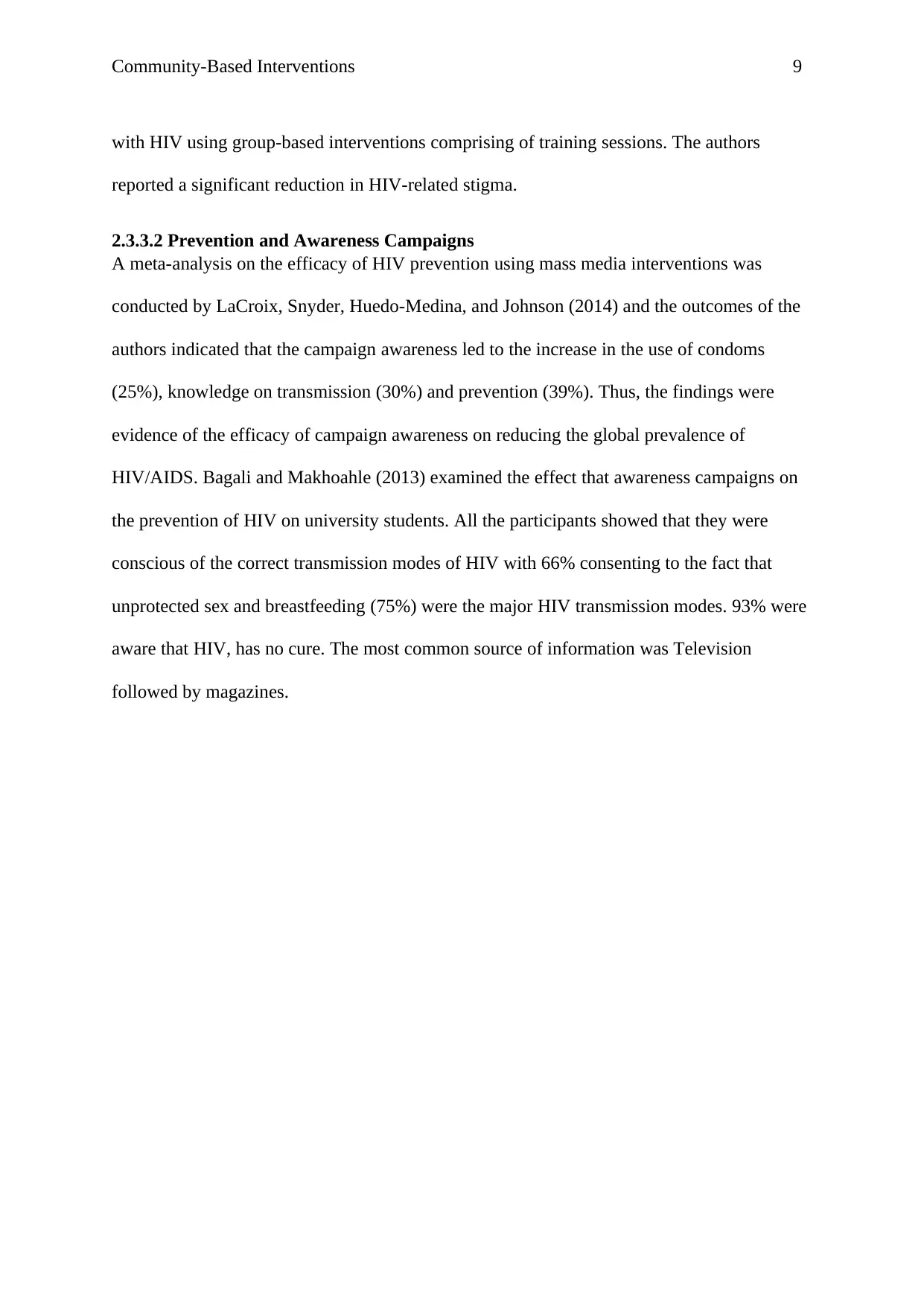
Community-Based Interventions 9
with HIV using group-based interventions comprising of training sessions. The authors
reported a significant reduction in HIV-related stigma.
2.3.3.2 Prevention and Awareness Campaigns
A meta-analysis on the efficacy of HIV prevention using mass media interventions was
conducted by LaCroix, Snyder, Huedo-Medina, and Johnson (2014) and the outcomes of the
authors indicated that the campaign awareness led to the increase in the use of condoms
(25%), knowledge on transmission (30%) and prevention (39%). Thus, the findings were
evidence of the efficacy of campaign awareness on reducing the global prevalence of
HIV/AIDS. Bagali and Makhoahle (2013) examined the effect that awareness campaigns on
the prevention of HIV on university students. All the participants showed that they were
conscious of the correct transmission modes of HIV with 66% consenting to the fact that
unprotected sex and breastfeeding (75%) were the major HIV transmission modes. 93% were
aware that HIV, has no cure. The most common source of information was Television
followed by magazines.
with HIV using group-based interventions comprising of training sessions. The authors
reported a significant reduction in HIV-related stigma.
2.3.3.2 Prevention and Awareness Campaigns
A meta-analysis on the efficacy of HIV prevention using mass media interventions was
conducted by LaCroix, Snyder, Huedo-Medina, and Johnson (2014) and the outcomes of the
authors indicated that the campaign awareness led to the increase in the use of condoms
(25%), knowledge on transmission (30%) and prevention (39%). Thus, the findings were
evidence of the efficacy of campaign awareness on reducing the global prevalence of
HIV/AIDS. Bagali and Makhoahle (2013) examined the effect that awareness campaigns on
the prevention of HIV on university students. All the participants showed that they were
conscious of the correct transmission modes of HIV with 66% consenting to the fact that
unprotected sex and breastfeeding (75%) were the major HIV transmission modes. 93% were
aware that HIV, has no cure. The most common source of information was Television
followed by magazines.
⊘ This is a preview!⊘
Do you want full access?
Subscribe today to unlock all pages.

Trusted by 1+ million students worldwide

Community-Based Interventions 10
CHAPTER THREE: PROPOSED ACTION PLAN
3.1 Study Method
This study will adopt a qualitative case study design to ascertain the effectiveness of
community nursing based intervention on HIV prevention and reduction on people living
with HIV/AIDS (PLHA) in Queensland Australia.
3.2 Target Population
The target population will consist of 100 PLHA in Queensland Australia
3.3 Sampling Methods
The researcher will use purposive sampling to identify the study subjects based on the
following inclusion criteria:
The participants must be HIV positive for at least 24 weeks
The participants must be 18 years and above
The participants must be living in Queensland as at the time of the research
It is mandatory for the participants to be fluent in English
The participants have to be ready and willing to share their life experiences during
the in-depth interview
It is mandatory that the participants be willing to consent to the audio recording of
the conversation
3.4 Sample Size and Power
The sample size for the study will be determined using Cronbach's formula as demonstrated
below:
CHAPTER THREE: PROPOSED ACTION PLAN
3.1 Study Method
This study will adopt a qualitative case study design to ascertain the effectiveness of
community nursing based intervention on HIV prevention and reduction on people living
with HIV/AIDS (PLHA) in Queensland Australia.
3.2 Target Population
The target population will consist of 100 PLHA in Queensland Australia
3.3 Sampling Methods
The researcher will use purposive sampling to identify the study subjects based on the
following inclusion criteria:
The participants must be HIV positive for at least 24 weeks
The participants must be 18 years and above
The participants must be living in Queensland as at the time of the research
It is mandatory for the participants to be fluent in English
The participants have to be ready and willing to share their life experiences during
the in-depth interview
It is mandatory that the participants be willing to consent to the audio recording of
the conversation
3.4 Sample Size and Power
The sample size for the study will be determined using Cronbach's formula as demonstrated
below:
Paraphrase This Document
Need a fresh take? Get an instant paraphrase of this document with our AI Paraphraser
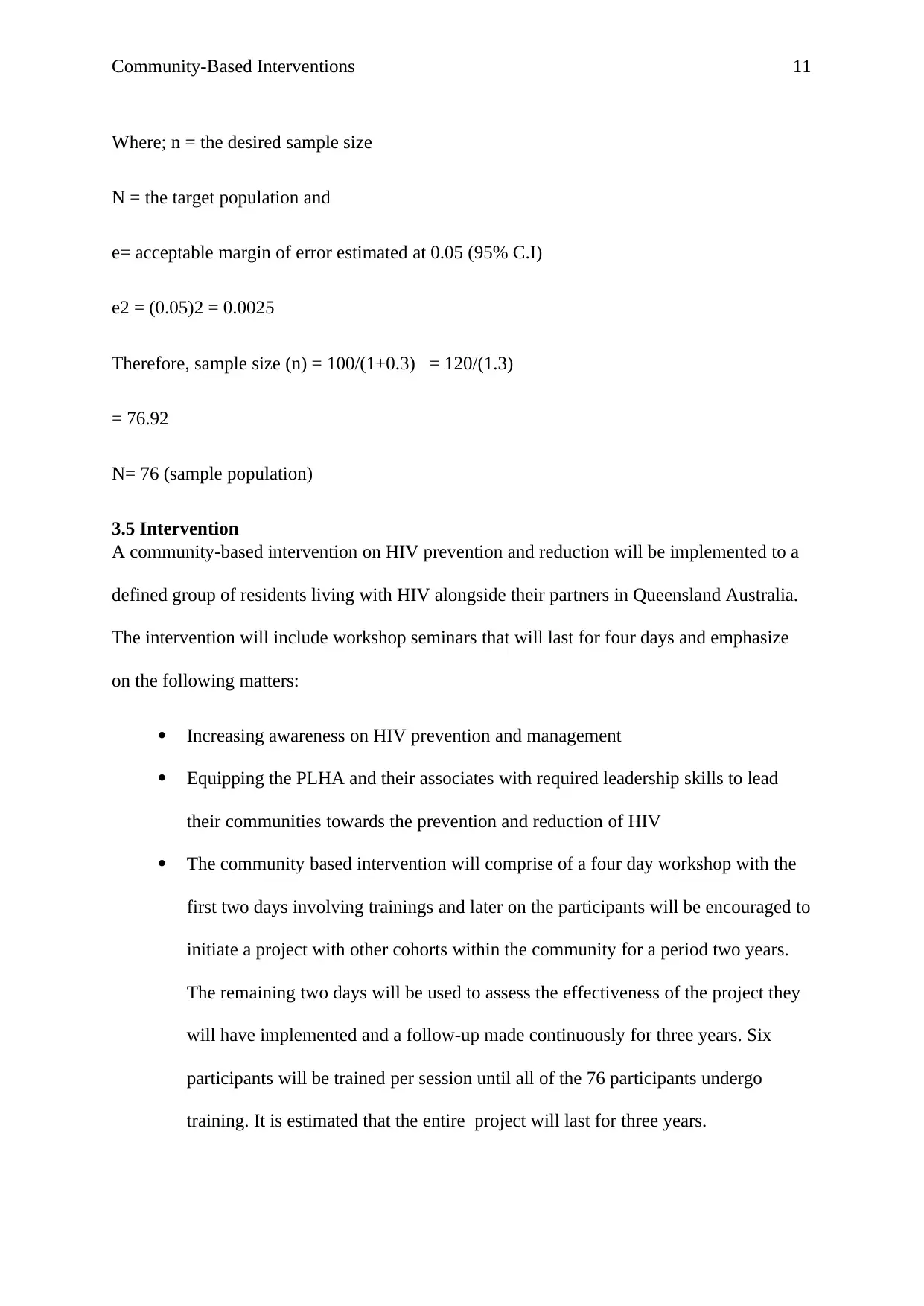
Community-Based Interventions 11
Where; n = the desired sample size
N = the target population and
e= acceptable margin of error estimated at 0.05 (95% C.I)
e2 = (0.05)2 = 0.0025
Therefore, sample size (n) = 100/(1+0.3) = 120/(1.3)
= 76.92
N= 76 (sample population)
3.5 Intervention
A community-based intervention on HIV prevention and reduction will be implemented to a
defined group of residents living with HIV alongside their partners in Queensland Australia.
The intervention will include workshop seminars that will last for four days and emphasize
on the following matters:
Increasing awareness on HIV prevention and management
Equipping the PLHA and their associates with required leadership skills to lead
their communities towards the prevention and reduction of HIV
The community based intervention will comprise of a four day workshop with the
first two days involving trainings and later on the participants will be encouraged to
initiate a project with other cohorts within the community for a period two years.
The remaining two days will be used to assess the effectiveness of the project they
will have implemented and a follow-up made continuously for three years. Six
participants will be trained per session until all of the 76 participants undergo
training. It is estimated that the entire project will last for three years.
Where; n = the desired sample size
N = the target population and
e= acceptable margin of error estimated at 0.05 (95% C.I)
e2 = (0.05)2 = 0.0025
Therefore, sample size (n) = 100/(1+0.3) = 120/(1.3)
= 76.92
N= 76 (sample population)
3.5 Intervention
A community-based intervention on HIV prevention and reduction will be implemented to a
defined group of residents living with HIV alongside their partners in Queensland Australia.
The intervention will include workshop seminars that will last for four days and emphasize
on the following matters:
Increasing awareness on HIV prevention and management
Equipping the PLHA and their associates with required leadership skills to lead
their communities towards the prevention and reduction of HIV
The community based intervention will comprise of a four day workshop with the
first two days involving trainings and later on the participants will be encouraged to
initiate a project with other cohorts within the community for a period two years.
The remaining two days will be used to assess the effectiveness of the project they
will have implemented and a follow-up made continuously for three years. Six
participants will be trained per session until all of the 76 participants undergo
training. It is estimated that the entire project will last for three years.
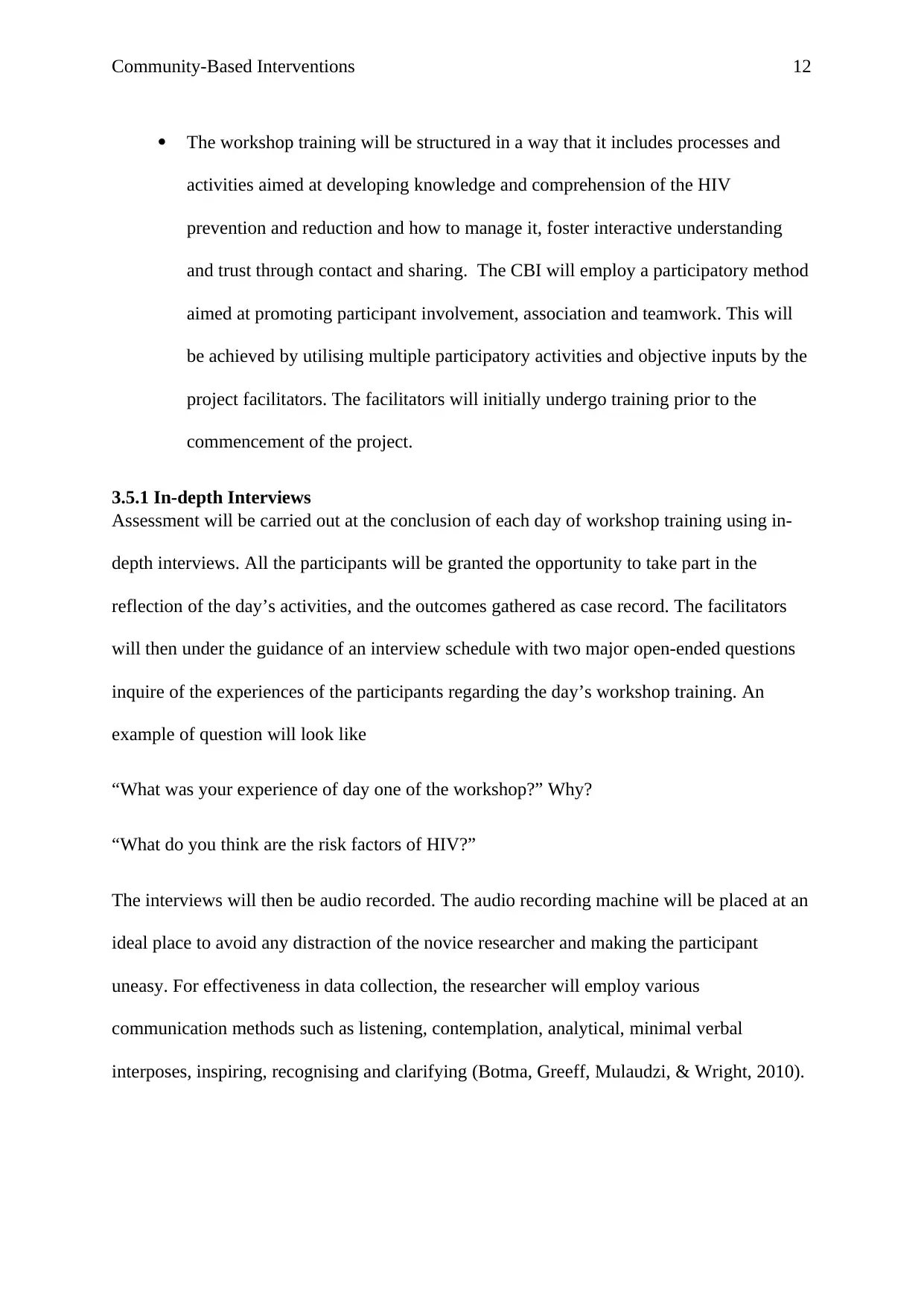
Community-Based Interventions 12
The workshop training will be structured in a way that it includes processes and
activities aimed at developing knowledge and comprehension of the HIV
prevention and reduction and how to manage it, foster interactive understanding
and trust through contact and sharing. The CBI will employ a participatory method
aimed at promoting participant involvement, association and teamwork. This will
be achieved by utilising multiple participatory activities and objective inputs by the
project facilitators. The facilitators will initially undergo training prior to the
commencement of the project.
3.5.1 In-depth Interviews
Assessment will be carried out at the conclusion of each day of workshop training using in-
depth interviews. All the participants will be granted the opportunity to take part in the
reflection of the day’s activities, and the outcomes gathered as case record. The facilitators
will then under the guidance of an interview schedule with two major open-ended questions
inquire of the experiences of the participants regarding the day’s workshop training. An
example of question will look like
“What was your experience of day one of the workshop?” Why?
“What do you think are the risk factors of HIV?”
The interviews will then be audio recorded. The audio recording machine will be placed at an
ideal place to avoid any distraction of the novice researcher and making the participant
uneasy. For effectiveness in data collection, the researcher will employ various
communication methods such as listening, contemplation, analytical, minimal verbal
interposes, inspiring, recognising and clarifying (Botma, Greeff, Mulaudzi, & Wright, 2010).
The workshop training will be structured in a way that it includes processes and
activities aimed at developing knowledge and comprehension of the HIV
prevention and reduction and how to manage it, foster interactive understanding
and trust through contact and sharing. The CBI will employ a participatory method
aimed at promoting participant involvement, association and teamwork. This will
be achieved by utilising multiple participatory activities and objective inputs by the
project facilitators. The facilitators will initially undergo training prior to the
commencement of the project.
3.5.1 In-depth Interviews
Assessment will be carried out at the conclusion of each day of workshop training using in-
depth interviews. All the participants will be granted the opportunity to take part in the
reflection of the day’s activities, and the outcomes gathered as case record. The facilitators
will then under the guidance of an interview schedule with two major open-ended questions
inquire of the experiences of the participants regarding the day’s workshop training. An
example of question will look like
“What was your experience of day one of the workshop?” Why?
“What do you think are the risk factors of HIV?”
The interviews will then be audio recorded. The audio recording machine will be placed at an
ideal place to avoid any distraction of the novice researcher and making the participant
uneasy. For effectiveness in data collection, the researcher will employ various
communication methods such as listening, contemplation, analytical, minimal verbal
interposes, inspiring, recognising and clarifying (Botma, Greeff, Mulaudzi, & Wright, 2010).
⊘ This is a preview!⊘
Do you want full access?
Subscribe today to unlock all pages.

Trusted by 1+ million students worldwide
1 out of 28
Related Documents
Your All-in-One AI-Powered Toolkit for Academic Success.
+13062052269
info@desklib.com
Available 24*7 on WhatsApp / Email
![[object Object]](/_next/static/media/star-bottom.7253800d.svg)
Unlock your academic potential
Copyright © 2020–2025 A2Z Services. All Rights Reserved. Developed and managed by ZUCOL.





